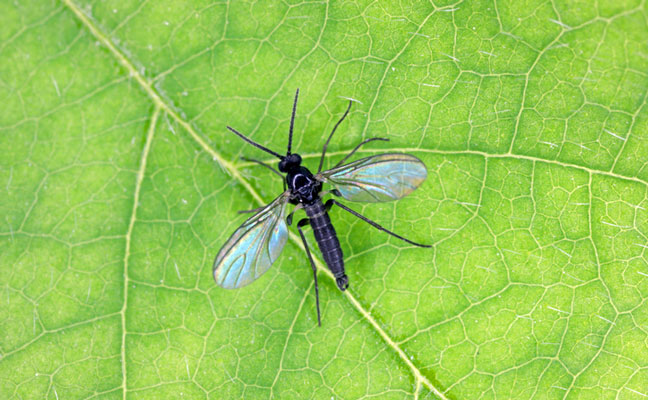
Photo: Tomasz Klejdysz/iStock / Getty Images Plus/Getty Images
Fungus gnats (Sciaridae) can be a nuisance in indoor environments, as their presence can be unsightly and their larvae can cause damage to plants. Additionally, adult fungus gnats can be a nuisance as they fly around and can be attracted to lights, often flying in people’s faces or landing on food or surfaces.
While fungus gnats do not pose a direct threat to human health, their presence can be bothersome and can also indicate potential issues with plant health or moisture control in the indoor environment. It’s important to address and control fungus gnat infestations to maintain a healthy and comfortable indoor environment.
Like other pests, understanding the biology, habits and habitats of fungus gnats is needed to develop an effective management plan. In addition to the organic matter in growing media, such as decaying plant debris, fungus gnat larvae also feed on fungi and bacteria as supplemental food sources needed for growth. This has been observed and documented in studies by Baumberger (1919) and Brues (1946). Fungi and bacteria are commonly found in soil and growing media and can provide additional nutrients for the larvae to develop and grow. However, it’s important to note that excessive feeding by fungus gnat larvae on plant roots and other plant material can lead to damage and adversely affect plant health. Fungus gnats can be a nuisance in indoor environments, and it’s important to identify and treat the source of the infestation to control their population.
Yello/blue sticky traps and insect light traps (ILTs) can be useful tools for monitoring and detecting adult fungus gnats, but they may not be as effective in identifying the breeding sources of fungus gnat larvae. To locate and eliminate the breeding sources of fungus gnats, a thorough inspection of the growing media and surrounding areas is necessary.
When inspecting for fungus gnat larvae breeding sources, it’s important to check the growing media of plants for signs of larvae, such as tiny white or transparent worm-like creatures with a black heads. The growing media may also appear to be excessively damp or moist, which can be a sign of overwatering or poor drainage, providing an ideal breeding ground for fungus gnats. The presence of mushrooms or other fungal growth on the surface of the growing media can also indicate a high level of organic matter, which is attractive to fungus gnats.
In addition to inspecting plants and growing media, it’s also important to inspect surrounding areas for potential breeding sources, such as decomposing plant material, standing water, or damp areas in and around the structure. Cracks and gaps in walls, foundations, and other entryways can also provide access for fungus gnats to enter the building and should be inspected and sealed if necessary.

Dr. Mohammed El Damir, BCE
The treatment of fungus gnats depends on whether they are breeding indoors or outdoors. If the gnats are entering from outside, locating and treating the entryways can be challenging. Dusting residual insecticides into cracks and gaps where the gnats are entering, or using granular insecticides in soil and mulch around the structure, may provide some control, but it may not be enough to keep them at bay. Using residual insecticides labeled for exterior treatment, along with treating ornamental plants around the structure, can also help. It’s important to follow the label instructions carefully when using any insecticide and to ensure that any products used are approved for use in the intended area. If the infestation persists despite these efforts, it may be necessary to apply thorough inspection to locate possible entryways, with a pest management professional for further assistance.
In conclusion, understanding the biology and habits of fungus gnats is crucial in developing an effective management plan. This includes identifying the breeding sources, which may be indoor plants or outdoor entryways, and selecting appropriate treatments such as approved residual insecticides and IGRs for indoor infestations or exterior treatments for outdoor sources. Thorough inspection and monitoring techniques, such as sticky traps and insect light traps, can also help identify the breeding sources and monitor the effectiveness of the treatment plan. It’s also important to note that prevention is key to controlling fungus gnats. Avoid overwatering plants, as this can create a moist environment that is ideal for fungus gnat larvae. Use well-draining soil and containers with adequate drainage holes to allow excess water to escape.
The post How to deal with fungus gnats appeared first on Pest Management Professional.
from Pest Management Professional https://www.mypmp.net/2023/03/06/how-to-deal-with-fungus-gnats/
Sacramento CA
No comments:
Post a Comment